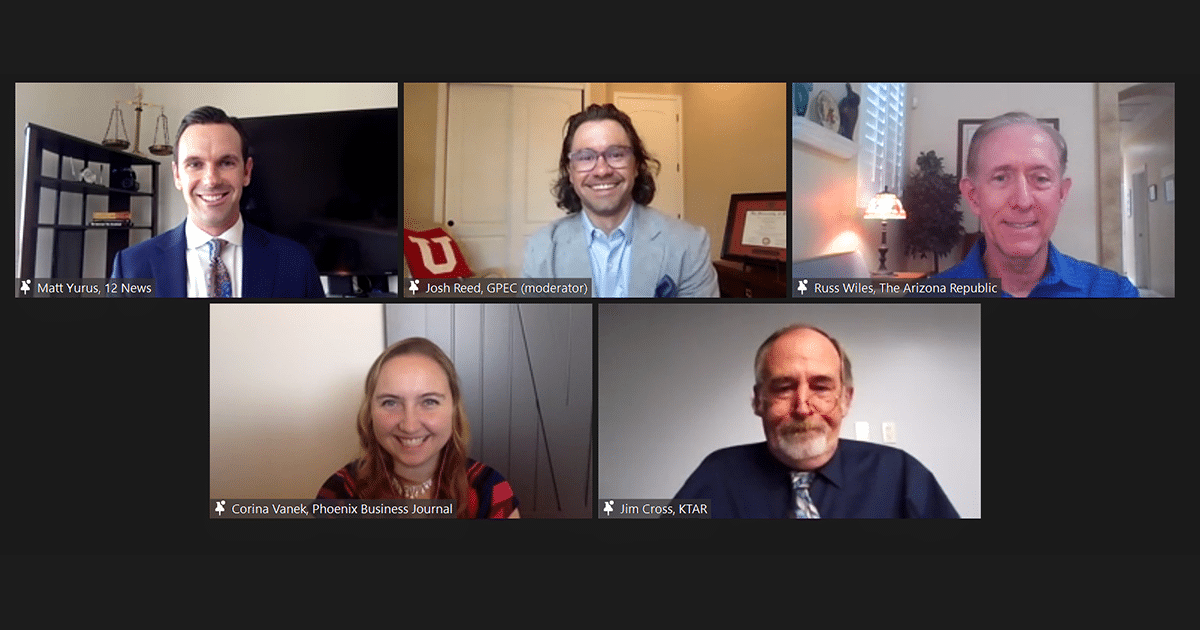

Ambassador Event: Media Insights, Getting Your Story Told
Published: 04/21/2021
Updated: 09/22/2021
How to get media coverage and better connect with local reporters
There are 686 reporters in Greater Phoenix and 570,000+ businesses and municipalities across the state, according to Emsi data. Factor in companies from all over the world, breaking news, statewide and national stories taking precedent; it’s difficult to get your story told as an organization or city.
To help, we hosted four journalists from Arizona news outlets at our latest ambassador event to discuss best practices for building relationships with press and developing streamlined media materials to best get your news in front the appropriate reporter, and ultimately readers, viewers and listeners.
Panelists included:
- Jim Cross, Senior News Reporter, KTAR
- Corina Vanek, Reporter, Phoenix Business Journal
- Russ Wiles, Business Writer/Columnist, The Arizona Republic
- Matt Yurus, Anchor & Reporter, 12 News
Here are the media insights from the journalists:
Do your research
Reporters are busy. Hundreds of pitches flood their inboxes daily. Make sure you’re not wasting your time and theirs by emailing the wrong journalist or outlets.
Different outlets focus on different stories. For instance, the Arizona Republic has stepped away from earnings reports, smaller hiring announcements and similar business-to-business topics, while the Phoenix Business Journal targets business audiences and decision-makers with its focus on B2B editorial. Similarly, individual reporters have different tastes in what qualifies as news.
“Each newsroom has its own culture. Each reporter has his or her own preferences,” Yurus said. “Watch the newscasts from time to time, just have an idea of what they’re covering and how they’re getting to it.”
If you’re not getting media coverage, it might not be because your story isn’t a good one – you might just be targeting the wrong person. Look through staff directories and review reporters’ portfolios or newscasts to find the proper journalist.
“I get 400 press releases (and messages) a day, and 300 of them are worthless because they’re being sent to the wrong person,” Wiles said. “I think that really quick tip can help maybe push you in the right direction.”
Writing the press release
When Wiles’ inbox has 400 press releases in it, he doesn’t have time to read a lengthy press release.
“Keep it short, to the point and understandable. It shouldn’t need to be more than three or four paragraphs. You’re not necessarily telling the whole story, you’re just trying to get us to bite a little bit,” he said. “We’re most likely just going to be looking, initially at least, and making our decision, on the first couple paragraphs.”
Make sure this press release contains the pertinent information. If this is an event, include the date and location. If it’s a data-based story, include the crucial numbers. Make sure there are key points the reporter would ask you about to help kickstart the process.
Then, be prepared to talk about specific insights in a way that someone unfamiliar with the topic can understand it.
“You must know what the exact message is. You then must repeat it and you must keep it simple,” Yurus said.
“Know what you’re pitching. Know what the story is. Know what the key takeaways are going to be,” Vanek added. “The reporter frankly doesn’t have the time to go through your whole business story with you to decide what’s important and what’s not.”
The press release is just the first step to media coverage. If it piques the reporter’s interest, he or she will likely reach out for an interview. Make yourself ready and available to talk.
“I don’t want to re-write your press release — I didn’t go to college for that,” Vanek said. “The press release is a good way to get attention, but don’t leave it at that.”
Broader story lines affecting a wide range of people tend to attract the attention of more journalists. Wiles mentioned he has interest in covering trends, analysis and human-interest stories.
The more people who are impacted by it, the more interest there will be.
“It almost has to affect a lot of people. Something that people can use in their daily lives. Information that they need,” Cross said. “The more people a story affects, the easier it is to put together.”
Furthering the connection
The press release is a good starting point to connect with media members, but it shouldn’t be the end point. Many reporters prefer correspondence through text, phone call or personal email to help cut through the clutter of the newsroom inbox.
Once trust has been established between the two parties, it will be easier to communicate and continue getting your story told.
One way to do this is to make yourself available even if you don’t have a pitch.
“Reaching out when maybe you don’t need a favor is also a good thing, just checking into see… if there’s any information your business can provide,” Vanek said. “That always makes the reporter a little bit more likely to turn to you when they do need something, or when you have a pitch that you want covered, knowing that person and having that give-and-take is always a good thing.”
As in most areas of life and business, media coverage comes down to relationships.
“I have relationships going back decades,” Cross said. “I count on these people and I think to some degree they count on me, and if the story’s good enough and they pitch it to me, it’s going to get airtime.”